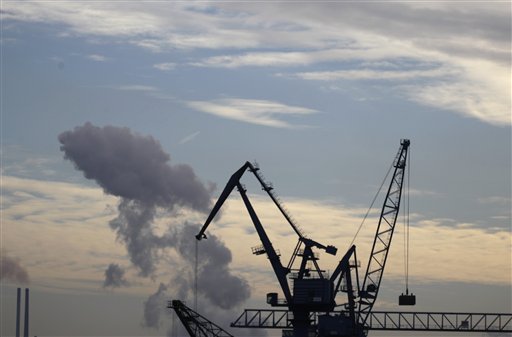By PAN PYLAS
Associated Press
LONDON
Europe is edging closer to recession, dragged down by the crippling debt problems of the 17-country euro bloc, official figures showed Tuesday.
Eurostat, the European Union’s statistics agency, revealed that the economies of both the eurozone and the wider 27-country EU shrank by a quarterly rate of 0.2 percent in the second quarter of the year. In the first quarter, output for both regions was flat. A recession is officially defined as two straight quarters of falling output.
Europe’s debt woes have been blamed for the sharp deterioration in the global economic outlook over the last few months. The region is the U.S.’s largest export customer and any fall-off in demand will hit order books _ as well as President Barack Obama’s election prospects.
The eurozone is grappling with sky-high debt levels and record unemployment of 11.2 percent. Compared with the year before, the eurozone’s economy is 0.4 percent smaller.
The region’s economy would have slipped into recession had it not been for better-than-expected GDP figures from its two leading economies, Germany and France. Figures for Germany, Europe’s biggest economy, posted quarterly growth of 0.3 percent, better than the 0.2 percent uptick it had been forecast. France also beat expectations of a small contraction in its output to record no change in its economy for the second quarter.
The region’s stumbling economy is making it harder for other economies to grow. Policymakers from around the world are urging more decisive action _ particularly from the European Central Bank _ to deal with the crippling debt crisis to restore confidence to the global economy.
Markets have grown more optimistic recently that Europe’s firefighting efforts will pick up the pace. That positive tone continued Tuesday, largely because of the figures out of Germany. The Stoxx 50 index of leading European shares was up 0.6 percent while the euro rose another 0.1 percent to $1.2350.
Germany currently benefits from strong demand for its products, but its high-value exporters are finding it increasingly difficult to tap international markets. Forward-looking surveys, including Tuesday’s closely-monitored ZEW survey of German investor sentiment, are suggesting that confidence is taking a knock as Europe moves from one crisis point to another.
The other 16 countries that use the euro are Germany’s biggest export market and six of them are in recession. The U.S. recently recorded GDP growth in the second quarter down compared to the previous three months at 0.4 percent, according to Eurostat.
Slower economic growth is also making it harder for governments and central banks to control the debt crisis in Europe. Shrinking economies make it more difficult to get the public finances into shape; lower output dents tax revenues while forcing up the cost of social benefits.
For those countries at the front-line of Europe’s debt crisis, the figures make for grim reading. Unsurprisingly, Greece is faring the worst _ its economy is 6.2 percent smaller than a year ago and back at the level it was in 2005.
Portugal, which has also been bailed out and enacting the tough austerity medicine, suffered a big 1.2 percent drop in output in the second quarter, compared with the previous quarter’s modest 0.1 percent drop.
Italy and Spain, the eurozone’s third and fourth largest economies, shrank by 0.7 percent and 0.4 percent respectively in the second quarter. Both countries are struggling to convince markets they have a strategy to get a grip on their debts. Spain has even agreed to a bailout of its banks.
Alexander Schumann, chief economist at The Association of German Chambers of Industry and Commerce, urged Europe’s indebted countries to carry on with their reforms and that it won’t be long before they start reaping the rewards.

COMMENTS
Please let us know if you're having issues with commenting.